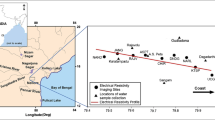Abstract
The Direct Current resistivity method was applied to the consolidated coastal Plioquaternary aquifer of Mamora plain, located on the Atlantic coast of Morocco. The aim is to determine the depth of the base of the saturated zone in the aquifer and to help in imaging lateral and vertical distribution of groundwater salinity. The geoelectric survey showed four geoelectric formations with the following electrical resistivities from top to bottom: 20–80, 200–2000, 200–300 and 5–70 Ohm m. The latter designates the basement of the aquifer constituted of marls and sandy marls. The mean resistivity of 250 Ohm m designates the aquifer formation. It decreases to less than 25% of its initial values for the soundings near the shore, reflecting the oceanic impact on the aquifer formation resistivity. The contour map shows that the basement of the saturated zone in the aquifer is deeper in the Northwest near the Sebou River estuary with values up to 70 m below sea level. This results in a larger thickness of the saturated zone of the aquifer leading to a consequent hydraulic potential. On the other hand, it has been deduced that the extent of marine intrusion inside the continent can be governed by human activities, natural properties and substratum geometry of the aquifer as well as by ecological factors. An optimal network of electrical soundings has been proposed for the monitoring of saltwater intrusion.








Similar content being viewed by others
References
Adepelumi A, Ako B, Ajayi T (2001) Groundwater contamination in the basement-complex area of Ile-Ife, southwestern Nigeria: a case study using the electrical-resistivity geophysical method. Hydrogeology J 9:611–622
Archie GE (1942) Electrical resistivity as an aid in core analysis interpretation. T Am I Min Eng 146:54–62
Arora CL, Bose RN (1981) Demarcation of fresch-and saline water zones, using electrical methods (Abohar area, Ferozepur district, Punjab). J Hydrology 49(1/2):75–86
Astier JL (1971) Géophysique appliquée à l’hydrogéologie, Masson et Cie, Paris
Ben Kabbour B (2002) Exploration, évaluation et protection des eaux souterraines de la Mamora côtière (Maroc): approches géophysique, hydrogéochimique, modélisation et S.I.G. PhD Thesis, Faculté des Sciences Kénitra, Maroc, 280 pp
Bose RN, Ramakrishna TS (1978) Electrical-resistivity surveys for groundwater in the Deccan trap country of Sangli District, Mahareshtra. J Hydrology 38(3/4):209–221
BRGM (1988) Manuel d’utilisation de Grivel. Orléans, France, 20 pp
Combe M (1975) Le bassin Gharb-Mamora et les petits bassins septentrionaux des oueds Dradere et Soueire. In: Notes & Mémoires du Serv. Géol. Maroc 231(2):93–128
Dominico PA, Schwartz FW (1990) Physical and chemical hydrogeology. Wiley, New York, 824 pp
DRPE (1989) Etude du plan directeur intégré d’aménagement des eaux des bassins de Sebou, Bouregreg, Oum Er rbia et Tensift. Ressources en eaux souterraines. Note de synthèse, 20 pp
Flinch JF (1993) Tectonic evolution of the Gibraltar Arc. PhD Thesis, Rice University, Houston, 381 pp
Fretwell JD, Stewart MT (1981) Resistivity study of a coastal karst terrain, Florida. Groundwater 19(2): 156–162
Geotrade (2000) Manuel d’utilisation du résistivimètre. Geotrade, Switzerland
Griffiths DH, King RF (1965) Applied geophysics for geologists and engineers. The elements of geophysical prospecting. Pergamon Press, Oxford, 230 pp
Hobbs BA, Reading AM (1987) Shallow faults location in coal measures using offset Wenner resistivity profiling. Geophys Prospect 42:343–356
Keller YGV, Frischknecht FC (1966) Electrical methods in geophysical prospecting. In: International series in electromagnetic waves, vol 10. Pergamon Press, Oxford, 519 pp
Kundu N, Panigrahi MK, Sharma SP, Tripathy S (2002) Delineation of fluoride contaminated groundwater around a hot spring in Nayagarh, Orissa, India, using geochemical and resistivity studies. Environ Geol 43:228–235
Merrick NP (1997) The electrical resistivity method. In: Zannetti P (ed) Environmental modeling volume 3: computer methods and software for simulating environmental pollution and its adverse effects. Computational Mechanics Publications, Southampton, Boston, 496pp
ONEP (Office National de l’Eau Potable) (1995) Etude de traçage au sel dans le champs captant de sidi Taibi. Suivi du traçage par prospection électrique. ONEP/GTZ, Maroc
Seara JL, Granda A (1987) Interpretation of IP time domain/resistivity soundings for delineating sea-water intrusions in some coastal area of the Northeast of Spain. Geoexploration 24:153–167
Seguin Mk (1985) La géophysique et les propriétés physiques des roches. Les presses de l’Univ Laval, Québec
Stadelhofen MK, Meyer C (1991) Applications de la géophysique au recherches d’eau. Techniques et documentation, Lavoisier, France
Thanassoulas C, Tselentis G-A, Kolios N(1986) Geothermal prospecting by geoelectric soundings in NE Greece. Geophysical Prospecting 34:83–97
Todd DK (1980) Groundwater hydrology. Wiley, New York
Zouhri L, Lamouroux C, Vachard D, Pique A (2001) Les corps perméables plio-quaternaires de la Mamora (Maroc). Géométrie et influence structurale. Earth Planet Sci 332:1–4
Author information
Authors and Affiliations
Corresponding author
Rights and permissions
About this article
Cite this article
Benkabbour, B., Toto, E.A. & Fakir, Y. Using DC resistivity method to characterize the geometry and the salinity of the Plioquaternary consolidated coastal aquifer of the Mamora plain, Morocco. Env Geol 45, 518–526 (2004). https://doi.org/10.1007/s00254-003-0906-y
Received:
Accepted:
Published:
Issue Date:
DOI: https://doi.org/10.1007/s00254-003-0906-y




